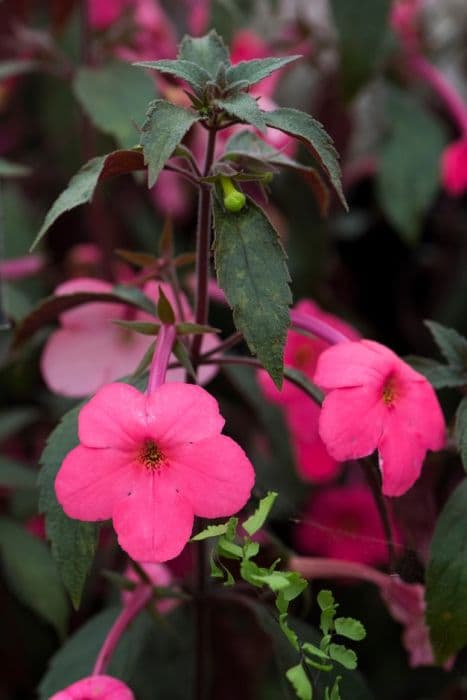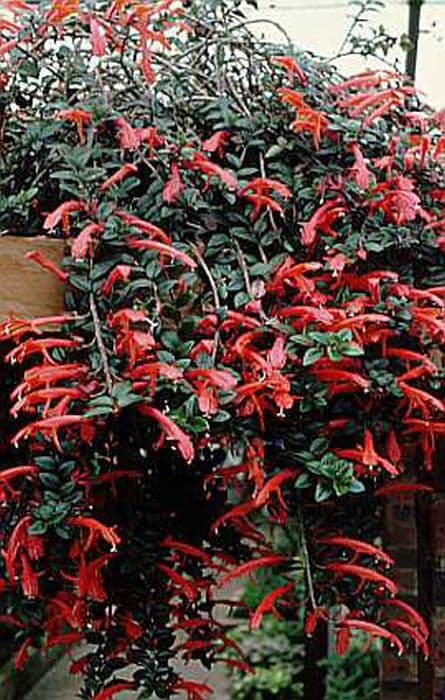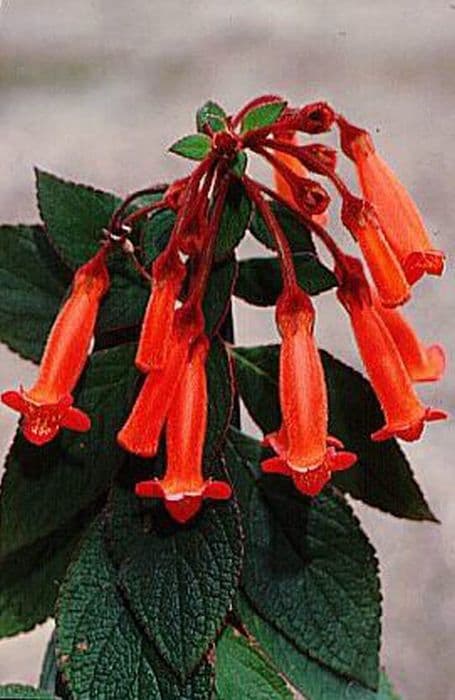Cape Primrose Streptocarpus 'Purple Velvet'

ABOUT
Streptocarpus 'Purple Velvet' is a visually striking houseplant known for its lush and velvety appearance. The leaves are long and textured, with a soft, almost furry feel, resembling those of its common cousin, the African Violet. Each leaf spreads out from the base of the plant, forming a rosette-like pattern that is both elegant and compact. The most captivating feature of Streptocarpus 'Purple Velvet' is its flowers. These blooms are richly colored in deep shades of purple that can sometimes appear almost black, making a dramatic contrast with the green foliage. The flowers have a trumpet-like form, with a flared mouth and five distinct lobes, contributing to their ornamental appeal. These blooms are carried above the foliage on slender flower stalks, giving them a hovering effect that is quite delightful to behold. The overall impression of Streptocarpus 'Purple Velvet' is one of luxurious richness and tactile allure, with a color palette that commands attention and makes it a favorite among lovers of indoor plants.
About this plant
 Names
NamesFamily
Gesneriaceae
Synonyms
Cape Primrose, African Violet Cousin, Twilight Plant
Common names
Streptocarpus 'Purple Velvet'.
 Toxicity
ToxicityTo humans
Cape Primrose, commonly known as Streptocarpus 'Purple Velvet', is not known to be toxic to humans. There are no significant symptoms of poisoning associated with this plant as it is generally considered non-toxic. Ingesting parts of Cape Primrose is unlikely to cause any harm or adverse health consequences.
To pets
Cape Primrose is also not known to be toxic to pets. It is considered non-poisonous for cats, dogs, and other household pets. Therefore, ingestion of this plant should not cause any symptoms of poisoning or lead to any concerning health consequences for animals.
 Characteristics
CharacteristicsLife cycle
Perennials
Foliage type
Evergreen
Color of leaves
Green
Flower color
Purple
Height
1 foot (30 cm)
Spread
1 foot (30 cm)
Plant type
Herb
Hardiness zones
10
Native area
Africa
Benefits
 General Benefits
General Benefits- Easy to Care: Streptocarpus, also known as Cape Primrose, is low-maintenance and can thrive with minimal attention.
- Long Blooming Period: Cape Primrose often has a long flowering period, providing color and interest for much of the year.
- Compact Size: These plants are suitable for small spaces because they don't take up much room.
- Aesthetic Appeal: With its velvety purple flowers, it can add a touch of elegance to any indoor setting.
- Variety of Colors: Although the 'Purple Velvet' variety is purple, Cape Primrose comes in a range of colors, offering versatility in design options.
- Shade Tolerance: This plant can perform well in partially shaded indoor environments where other plants might not thrive.
 Medical Properties
Medical PropertiesThis plant is not used for medical purposes.
 Air-purifying Qualities
Air-purifying QualitiesThis plant is not specifically known for air purifying qualities.
 Other Uses
Other Uses- Artistic Inspiration: The unique textures and deep purple hues of Streptocarpus can serve as a muse for artists and designers, inspiring everything from paintings to fabric patterns.
- Photography Subject: With its rich colours and velvety petals, it makes an excellent subject for macro photography, allowing photographers to capture the intricate details and beauty of the plant.
- Education: It can be used in educational settings, such as botany classes, to teach about plant morphology and the diversity of the Gesneriaceae family to which it belongs.
- Gift Plant: Due to its attractive appearance and relatively easy care, Streptocarpus plants are often gifted on special occasions such as housewarmings or as a symbol of friendship.
- Color Therapy: The vibrant purple color is sometimes used in color therapy, as some believe that being around the color purple can help stimulate imagination and creativity.
- Theme Gardens: They are perfect for creating a themed garden space that showcases shades of purple, allowing landscape designers to create a visually cohesive area.
- Floral Arrangements: Its fresh or dried flowers can be used to add a touch of elegance to floral arrangements or bouquets, especially for events that focus on a purple color scheme.
- Crafts: The flowers and leaves can be pressed and used in crafts such as handmade paper, bookmarks, or in resin jewellery.
- Relaxing Ambiance: Keeping a Streptocarpus in a bedroom or study could contribute to a relaxing ambiance, potentially helping to reduce stress with its aesthetically pleasing form.
- Collectors’ Item: Plant enthusiasts often collect various cultivars of Streptocarpus, including the 'Purple Velvet', making it a sought-after plant for rare plant collections.
Interesting Facts
 Feng Shui
Feng ShuiThe Cape primrose is not used in Feng Shui practice.
 Zodiac Sign Compitability
Zodiac Sign CompitabilityThe Cape primrose is not used in astrology practice.
 Plant Symbolism
Plant Symbolism- Enduring Love: The Streptocarpus, also known as Cape Primrose, often symbolizes enduring love due to its long-lasting flowers and the resilient nature of the plant.
- Charm and Cordiality: The velvety texture and vibrant color of the 'Purple Velvet' variety can represent charm and a welcoming demeanor, much like a warm and comfortable home.
- Adaptability and Resilience: Cape Primrose's ability to thrive in various light conditions reflects adaptability and resilience in diverse situations.
- New Beginnings: As a plant that can bloom at various times of the year, the Streptocarpus signifies new beginnings and hope.
 Water
WaterWhen watering Cape Primrose, you should aim to keep the soil consistently moist but not soggy. Use room temperature water to gently soak the soil, ensuring that water reaches the root zone without drenching the leaves. Typically, watering once every week with about 8 ounces of water is sufficient, but you must adjust the frequency depending on the humidity and light conditions. During the growing season, spring through fall, be more vigilant with watering, and reduce it in winter when plant growth slows down.
 Light
LightCape Primrose thrives in bright, indirect light. A north-facing window or an east-facing window with filtered morning sunlight is ideal. Direct afternoon sun can be too harsh and may cause leaf scorch. Ambient light without direct exposure to the sun’s rays will promote the best growth and flowering results.
 Temperature
TemperatureThe ideal temperature range for growing Cape Primrose is between 60 to 75 degrees Fahrenheit. They can survive in temperatures as low as 50 degrees Fahrenheit and as high as 80 degrees Fahrenheit, but for optimal growth and flowering, keep them within the ideal range. Avoid placing the plant in drafty areas or near heating and cooling vents, as extreme temperature fluctuations can stress the plant.
 Pruning
PruningPrune Cape Primrose to encourage bushier growth and more blooms. Snip off spent flowers and yellowing leaves with clean, sharp scissors. The best time for pruning is in the late winter or early spring, just before the new growth starts. Pruning every few months is generally sufficient to maintain its shape and vigor.
 Cleaning
CleaningAs needed
 Soil
SoilCape Primrose thrives in a well-drained, porous soil mix with a pH of 5.8 to 6.2. A mixture of half peat or coir with a quarter each of perlite and vermiculite works well for this plant.
 Repotting
RepottingCape Primroses should be repotted once a year, ideally in spring, to refresh the soil and accommodate root growth.
 Humidity & Misting
Humidity & MistingCape Primrose prefers humidity levels of about 50% but can tolerate a range from 40% to 60%.
 Suitable locations
Suitable locationsIndoor
Place in bright, indirect light with good humidity.
Outdoor
Grow in shade, shelter from harsh elements.
Hardiness zone
10-11 USDA
 Life cycle
Life cycleStreptocarpus 'Purple Velvet', commonly known as Cape Primrose, begins its life cycle as seeds which, when sown, germinate to produce small seedlings. The seedlings then develop into rosettes of leaves, a stage characterized by vegetative growth where the plant focuses on expanding its leaf span to gather sunlight. As the plant matures, it enters the flowering stage, developing distinctive velvety purple flowers that, if pollinated, can produce seeds for the next generation. The flowering phase can last several months, with flowers appearing in succession. After blooming, if conditions are not optimal for seed production or if seeds are not desired, spent flowers can be deadheaded to encourage additional blooming. Cape Primrose can be a long-lived plant, continuously going through cycles of vegetative growth and blooming when provided with the appropriate care and environmental conditions.
 Propogation
PropogationPropogation time
Spring-Summer
The Streptocarpus 'Purple Velvet', commonly known as Cape Primrose, is most effectively propagated through leaf cuttings, a method frequently undertaken during spring or early summer when the plant is actively growing. To propagate, a healthy leaf is chosen and a clean cut is made across the leaf, ensuring a few veins are intact. This cutting is then placed in a well-draining soil mix where the main veins come into contact with the soil. The pot is kept in a warm, shaded place and the soil is kept consistently moist but not waterlogged. Roots and new shoots will begin to develop from the veins, and once these shoots have established their own root systems, they can be separated gently from the parent leaf and repotted as individual plants. This approach leverages the plant's natural ability to regenerate from leaf tissue, making it an accessible and reliable method for gardeners to expand their collection of Cape Primrose.









